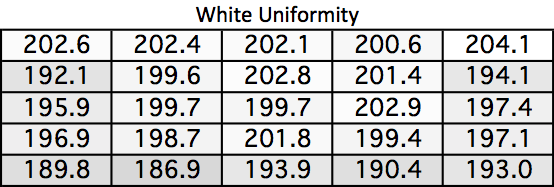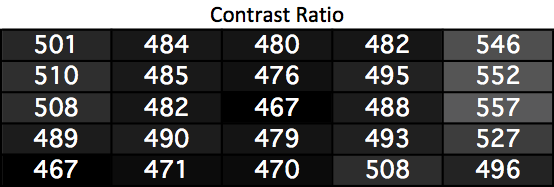Samsung S27B971D Monitor Review
by Chris Heinonen on October 31, 2013 12:00 PM ESTThe only way to describe the uniformity data is “also amazing.” Rivaling or even exceeding what I have seen from NECs professional displays, the uniformity of the S27B971D is superb. White uniformity is all within 8% of each other, which is likely to not be noticed in real life. Even the dimmest area on the screen only drops by 6% which I did not notice when using it. Like NEC the high-brightness setting probably affects uniformity as well, but using the sRGB mode it stays incredibly uniform.


Black levels have more of a fall-off but not for the usual reason. Typically black uniformity is bad because of some bright corners or edges, but here it is less uniform because the edges are darker. I’m not going to complain about this as it is much better than having bright corners around the screen. I’m assuming the higher overall black levels are due to the technology they are using to produce the uniformity in the display. As I mentioned with the calibration bench, if you need contrast ratios, you can use the movie mode for that. For work where color accuracy and uniformity are more important the sRGB mode is perfect.


With our white levels being totally stable the contrast uniformity varies due to the black levels. The good news is that it varies in a good way, with the edges of the screen being more dynamic than the center. It never exceeds 557:1 so it still lacks the pop of a VA panel, but it is very stable across the screen.


Saving the best for last, color uniformity is perfect. Only two values exceed 1.0 dE2000 on average when compared to the center, and the largest average is 1.23. When you look at an image on the screen, colors will match the rest of the screen and everything will look correct. Phenomenal results here from Samsung.

Despite Samsung billing this as a professional display, I didn’t expect these kinds of results. Even when I saw their 25-point calibration demo or the document that came with the display I didn’t expect it. However Samsung has made a display that ranks up with displays costing hundreds of dollars more in terms of uniformity and accuracy.










52 Comments
View All Comments
lemonadesoda - Tuesday, November 5, 2013 - link
After spending a fortune on an XL20 LED monitor some years back - I discovered that the Samsung IPS alternatives are good but not as good as tru IPS. I won't buy another.mr2kat - Tuesday, November 5, 2013 - link
Can someone explain to me - why would Samsung not calibrate this monitor before shipping? Is it a question of matching the monitor to the graphic card?